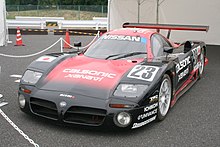Nissan R390 GT1
The Nissan R390 GT1 is a racing car that was built to compete in the 1997 and 1998 24 Hours of Le Mans . It was designed according to the regulations of the GT1 class, which required a road version homologated by the FIA .
development
After Nissan had entered the Le Mans 24 Hours in 1995 and 1996 with the Skyline GT-R LM , but this had no chance of winning against the upcoming, new generation of GT1 vehicles in the style of a McLaren F1-GTR or Porsche 911 GT1 , the decision was made the Nissan board to build a new supercar especially for this race. For the development of the car he turned to Tom Walkinshaw Racing (TWR). Based on the Nissan R380, a sports car from the 1960s , Nissan decided to name the new sports car R390.
The R390 was designed by Ian Callum, who had previously designed the Aston Martin DB7 . In order for the car to resemble Nissan's production vehicles, it used the lights of the 300ZX for the front end and integrated the two-part grille typical of Nissan. The rest of the shape and the aerodynamics were generated from countless wind tunnel tests with smaller models in England and later with the original at the Nissan Technical Center in Atsugi, Japan.
Tony Southgate , who had already designed the Jaguar XJR-9 that won Le Mans in 1988 , was responsible for the chassis . The engine of the R390 GT1 was based on the VRH35Z used in the Nissan R89C back in 1989 . The revised version was called the VRH35L, had eight cylinders and, with the help of a twin turbocharger, generated an output of around 641 hp (478 kW) at 6800 rpm from a displacement of 3496 cm 3 . In order to be able to transfer this power optimally to the asphalt, the R390 GT1 was given an automatic start control (launch control) and traction control, which prevented the wheels from spinning by reducing the amount of fuel injected into the cylinders. The engine and rear wheels were linked by a sequential 6-speed gearbox that enabled the 1098 kg heavy R390 GT1 to accelerate from 0 to 100 in 3.8 seconds.
Only one copy of the street version required by the regulations was built. It weighs 1180 kg, has an engine throttled to 345 hp and is now in Nissan's Zama (Kanagawa) office .
Races
For the 1997 Le Mans 24-hour race , TWR and Nissan launched three of the new R390 GT1s . After Nissan had set the fastest lap during the pre-qualification in May, the racing cars were among the favorites. In the warmer June, Nissan couldn't quite match the times achieved in the pre-qualification, but was still at the front. In the race, all three cars had problems with the cooling of the transmission, which cost some time and even led to car number 22 failing. A little later, the fastest car, number 21, also retired after a spin. The only car that held out finished the race 67 laps behind in twelfth place.
For the 1998 24 hour race , TWR had improved the reliability of the R390 and also optimized the aerodynamics. So the car got a so-called long tail to German Langheck - d. H. the rear was lengthened by thirteen centimeters - and a new, lower rear wing to further reduce air resistance. As stipulated by the regulations, this car was again available as a road version. In the qualifying sessions, the focus was now only on the race set-up, while Porsche, Toyota and Mercedes fought for pole. In the race there was a lack of speed compared to the competition, but reliability was no longer a problem, so that all four cars used could drive through the finish in formation flight. They finished third, five, six and ten.
Technical specifications
Nissan R390 GT1 (1997):
- Length in mm: 4590
- Width in mm: 1990
- Height in mm: 1143 mm
- Wheelbase in mm: 2710
- Weight in kg: approx. 1098
Nissan R390 GT1 (1998):
- Length in mm: 4720
- Width in mm: 2000
- Height in mm: 1143 mm
- Wheelbase in mm: 2710
- Weight in kg: approx. 1027

